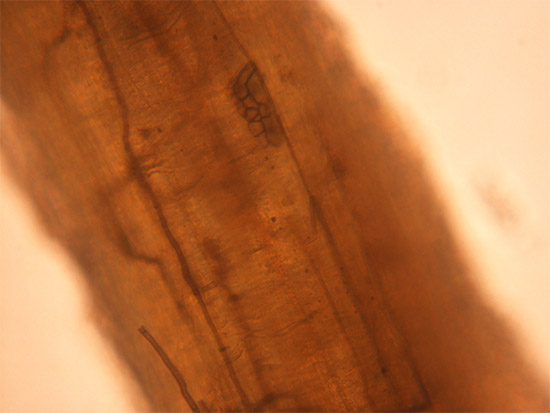Issue 16, September 20, 2016
Summer Patch in Lawns
The Plant Clinic has received a lot of turf samples this year, and recently many of them have been diagnosed with Summer Patch, a root rot caused by the fungus Magnaporthe poae. Kentucky bluegrass and fescues are the most commonly-affected types of lawn grass affected by this pathogen. As the name implies, Summer Patch usually becomes noticeable between June through September. Early infections may occur, but usually escape detection due to the turf recovering.
Summer Patch causes medium to large, circular or irregular, yellow or tan areas of dead and dying plants in the lawn. Healthy green grass may remain in the middle of the patch, resulting in a ring-like pattern of damage. These dead patches can coalesce, leading to large, splotchy areas of dead grass scattered across the lawn. The roots and crowns of the plants become dark brown and rot, leading to the death of the aerial parts of the grass.

Dark brown runner hyphae (left) and fungal structures (upper center) of M. poae in turfgrass root. Photo credit: University of Illinois Plant Clinic.
Management consists of keeping plants healthy through good lawn care, including core aeration, using the proper mowing height, appropriate fertilization, good watering practices, and reducing thatch. Symptoms of Summer Patch are worse when grass is kept mowed low, and during periods of drought stress. Consider choosing less susceptible species or varieties of grass when installing or overseeding a lawn.
If the disease is severe during the summer, a fall fungicide application followed by a spring application is recommended. From the 2014 Commercial Landscape and Turfgrass Pest Management Handbook: "Both applications should be made when the average soil temperature (2-in. depth at 10 a.m.) reaches about 68 to 70 F. Water the turf thoroughly the day before application with 0.25 to 0.5 in. (150 to 300 gal) of water per 1,000 sq ft. Unless directed otherwise, drench the fungicide into the root zone immediately after application using 0.5 to 1.0 (300 to 600 gal) of water per 1,000 sq ft. Rake out dead patches and re-seed with a mixture of turf species and / or varieties." (Diane Plewa)
Author:
Diane Plewa